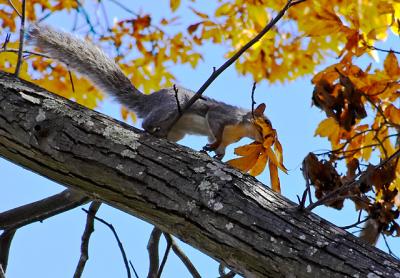Nature Notes: A Leaf Named Freddy

Fall marches on! At 6:30 last Thursday evening on a trip to Southampton Village by way of Deerfield and Edge of Woods Roads, both lanes were clear and only a single leaf fell. Three hours later on the return trip the roads were half leaf-covered while three dozen leaves floated down. Fall had begun in earnest.
Readers may remember that last fall, the oak leaves didn’t turn until near the end of November and forsythia shrubs were blooming for a second time. We may well be in the throes of global warming but you wouldn’t know it by the time of the leaf turn. When I was a boy growing up in Mattituck, across the bay, the oak leaves began reddening in the last week of October and by Halloween they were falling.
We didn’t have drones, cellphones, and the other myriad devices that kids have nowadays. We played games — tag, giant steps, ring-a-levio, knife, hide-and-seek, red light, and the like — to amuse ourselves. I invented a new game as an adolescent to go with the others: Catch a falling leaf. If it was calm it was an easy matter, but in a breeze it was difficult.
During one of these catch-a-leaf games I caught one that was so beautiful I took it home and for unfathomable reason named it Freddy. My family didn’t have a dog, so I kept and pampered that pet leaf for several weeks until it turned a morbid brown.
I haven’t tried leaf catching since, but I am still very aware of leaf turn and leaf fall. While living for 14 years on the West Coast I missed it. Now I revel in it. I guess you would have to say that October is my favorite month, notably because of the color of the leaves.
We didn’t have leaf blowers in the 1940s and 1950s. We mostly had bamboo rakes. A young boy could make a buck or two after school and on the weekends raking leaves off lawns and walkways. The custom was to rake the leaves to the edge of the road and into piles, then set fire to them. As they smoldered away they gave off a pleasant odor. Because of anti-pollution laws in effect these days that practice is no longer condoned. Noise pollution from leaf blowers is not as regulated.
Sometimes the leaf piles we made were so large that it became great fun to run and leap into them. If you did it correctly, your fall would be cushioned, as if you were falling on an air mattress.
Turning and falling leaves serve a purpose in nature. Squirrels that collect the acorns from oaks also often collect the fall leaves. What do they do with them? They use them to construct their dreys, circular nests of twigs and leaves to get them through winter storms and winter freezes.
I’ve never seen a squirrel make such a drey, but I have counted them in Southampton and East Hampton Towns during the last few years. On the other hand, Jean Held, who lives in eastern Sag Harbor, observed a gray squirrel in her yard fashion one of these winter abodes and even was able to photograph it carrying a leaf and incorporating it into a drey attached to a tree crotch in her yard.
Jean has both chipmunks and squirrels. The chipmunks hibernate underground. The squirrels remain active, but take long snoozes in their dreys. I count the dreys to see if they are related to squirrel numbers in a given year. Last fall was marked by an abundant acorn production. Acorns are one of the chief food items of gray squirrels. It would stand to reason that the more acorns, the more squirrels there are.
When acorns are scarce, or drop before ripening, the squirrels have to spend more time foraging. To fill their nutrition needs they often leave their home territories to forage elsewhere, and in doing so, often cross busy thoroughfares. The number of roadkill squirrels in a given year is a measure of the size of the squirrel population and the success or failure of the acorn crop. I would postulate that the gray squirrel population, which boomed after last year’s bountiful acorn crop, will suffer
a measurable decline in the coming spring. Comparing the number of dreys per mile of road this fall to the number next fall should bear out this notion.
A note of caution, however: I don’t know how to tell a gray squirrel drey from a flying squirrel drey. Flying squirrels, which have been increasing in number since populating the South Fork for the first time in this new millennium, are also known to make dreys for overwintering, especially when tree cavities are hard to come by. They prefer insects to acorns, thus the same reasoning doesn’t apply to them when postulating the ups and downs in their population.
Larry Penny can be reached via email at [email protected].
